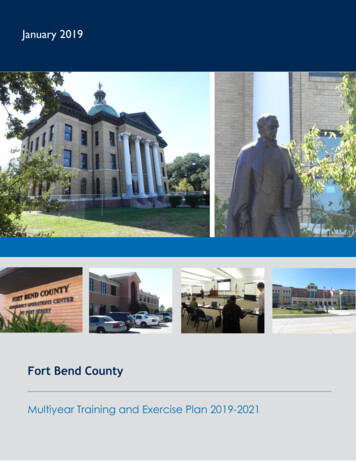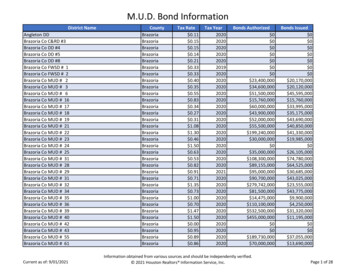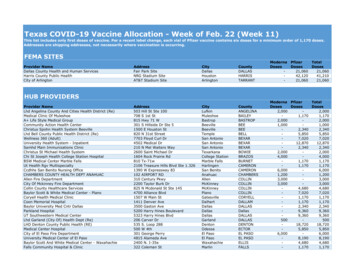
Transcription
January 2019Table of ContentsFort Bend CountyMultiyear Training and Exercise Plan 2019-2021Fort Bend County MTEP December 20180
Table of ContentsTable of ContentsPoints of Contact. 2Acronyms and Key Terms. 6Acronyms . 6Key Terms. 7Purpose . 9Maintenance . 9Training and Exercise Plan Workshop (TEPW) . 9Top Threats and Hazards . 10Critical Infrastructure and Key Resources (CIKR) . 12Priority Core Capabilities . 13Operational Coordination . 13Operational Communications . 14Public Information and Warning . 14Public Health, Healthcare, and Emergency Medical Services . 15Situational Assessment . 16Cybersecurity . 16Methodology and Tracking . 16Exercises Requirements . 16Multiyear Training and Exercise Schedule . 18Appendix A – Core Capabilities List. 24Appendix B – Improvement Plan and After-Action Report Analysis. 25Appendix C – Exercise Types . 26Discussion – Based . 26Operations – Based . 28Fort Bend County MTEP December 20181
Points of ContactPoints of ContactFort Bend CountyFort Bend County Health and Human Services (FBC HHS)Name:Title:Phone:E-Mail:David OlingerPublic Health Preparedness ytx.govName:Title:Phone:E-Mail:Yaneth Ramirez - CalderonPublic Information Specialist / Training and Exercise ntytx.govFort Bend County Office of Emergency Management (FBC OEM)Name:Title:Phone:E-Mail:Alan SpearsDeputy Emergency Management x.govName:Title:Phone:E-Mail:Kaila WilliamsPlanning Coordinator / CERT tytx.govName:Title:Phone:E-Mail:Charity DominguezPlanning Coordinator / Training and Exercise ountytx.govFort Bend County Sheriff’s Office (FBC SO)Name:Title:Phone:E-Mail:Jule endcountytx.govName:Title:Phone:E-Mail:Rodney ndcountytx.govFort Bend County MTEP December 20182
Points of eg GoedeckerEmergency Management lshearName:Title:Phone:E-Mail:Felix VargasEmergency Management ssouri CityName:Title:Phone:E-Mail:Dakota DuncanEmergency Management x.govRichmondName:Title:Phone:E-Mail:Ray BurciagaEmergency Management osenbergName:Title:Phone:E-Mail:Bill AdamsEmergency Management ordName:Title:Phone:E-Mail:Efrem BurnsEmergency Management Coordinator281-879-7397eburns@staffordtx.govFort Bend County MTEP December 20183
Points of ContactSugar LandName:Title:Phone:E-Mail:Pat HughesEmergency Management tle:Phone:E-Mail:Frank GarzaEmergency Management Specialist281-275-2805fgarza@sugarlandtx.govWeston LakesName:Title:Phone:E-Mail:Barrett ShepherdEmergency Management onlakes-tx.govHospitalsHouston Methodist - Sugar Land HospitalName:Title:Phone:E-Mail:Pete MunozEmergency Preparedness end Medical CenterName:Title:Phone:E-Mail:Loretta FlynnAssistant Vice President of Support Services281-633-4058lflynn@obmc.orgSchoolsFort Bend Independent School District (FBISD)Name:Title:Phone:E-Mail:Judy LefeversEmergency Management .comFort Bend County MTEP December 20184
Points of ContactKaty Independent School District (Katy ISD)Name:Title:Phone:E-Mail:Ruben MartinezEmergency Management amar Consolidated Independent School District (Lamar CISD)Name:Title:Phone:E-Mail:Trudy HarrisAssistant Director, Employee Services & Risk one:E-Mail:Dallis WarrenSafety ersity of Houston System, Cinco RanchName:Title:Phone:E-Mail:Nathan GreenAssistant Fire Marshal832-842-2921nagreen2@Central.UH.EDUFort Bend County MTEP December 20185
Acronyms and TermsAcronyms and Key ter Action ReportChemical, Biological, Radiological, Nuclear, ExplosivesCommunity Emergency Response TeamCritical Infrastructure Key ResourcesEmergency Management Performance GrantEmergency Operations CenterFort Bend CountyFunctional ExerciseFull Scale ExerciseHazardous MaterialsHealth and Human ServicesHomeland Security Exercise Evaluation ProgramIncident Command SystemImprovement PlanIndependent StudyIndependent School DistrictJoint Information CenterJoint Information SystemLevee Improvement DistrictLearning Management SystemMutual Aid AgreementMultiyear Training and Exercise PlanMultiyear Training and Exercise Planning GroupMunicipal Utility DistrictNational Incident Management SystemNational Response FrameworkOffice of Emergency ManagementCommodity Point of Distribution /Medical Point of DispensingReal World EventSheriff’s OfficeTexas Division of Emergency ManagementTraining and Exercise Planning WorkshopTable Top ExerciseVirtual Table Top ExerciseUrban Area Security InitiativeFort Bend County MTEP December 20186
Acronyms and TermsKey TermsCritical Infrastructure and Key Resources (CIKR) - Any system or asset vital to Fort Bend Countywhose incapacity or destruction would cause a devitalizing impact on physical, psychological, oreconomical security, public health or safety or any combination thereof.Core Capabilities – Thirty-two (32) distinct critical elements necessary to achieve the NationalPreparedness Goal.Exercise - An instrument to train for, assess, practice, and improve performance in prevention,protection, mitigation, response, and recovery capabilities in a risk-free environment. Exercisescan be used for testing and validating policies, plans, procedures, training, equipment, andinteragency agreements; clarifying and training personnel in roles and responsibilities; improvinginteragency coordination and communications; improving individual performance; identifyinggaps in resources; and identifying opportunities for improvement.Homeland Security Exercise and Evaluation Program (HSEEP) - A program that provides a set ofguiding principles for exercise programs, as well as a common approach to exercise programmanagement, design and development, conduct, evaluation, and improvement planning.Improvement Plan (IP) - The IP identifies specific corrective actions, assigns them to responsibleparties, and establishes target dates for their completion. The IP is developed in conjunction withthe After-Action Report.Incident Command System (ICS) – A management system designed to enable effective andefficient domestic incident management by integrating a combination of facilities, equipment,personnel, procedures, and communications operating within a common organizationalstructure.Progressive Approach - A progressive approach designated by the Homeland Security Exerciseand Evaluation Program that includes the use of various exercises aligned to a common set ofexercise program priorities and objectives with an increasing level of complexity over time.(Progressive exercise planning does not imply a linear progression of exercise types).National Incident Management System (NIMS) - The NIMS standard was designed to enhancethe ability of the United States to manage domestic incidents by establishing a single,comprehensive system for incident management. It is a nationwide approach for Federal, State,local, tribal, and territorial governments; the private sector; and nongovernmental organizationsto work effectively and efficiently together to prepare for, respond to, and recover from domesticincidents, regardless of cause, size, or complexity.Fort Bend County MTEP December 20187
Acronyms and TermsNational Preparedness Goal - The National Preparedness Goal defines the core capabilitiesnecessary to prepare for the specific types of incidents that pose the greatest risk to the securityof the Nation. The Goal emphasizes actions aimed at achieving an integrated, layered, and all-ofNation preparedness approach that optimizes the use of available resources. Specifically, theGoal defines success as: “A secure and resilient Nation with the capabilities required across thewhole community to prevent, protect against, mitigate, respond to, and recover from the threatsand hazards that pose the greatest risk.”Fort Bend County MTEP December 20188
PurposePurposeThe purpose of the Fort Bend County (FBC) Multiyear Training and Exercise Plan (MTEP) is todocument the process necessary to strengthen the core capabilities that are deemed essential inpreventing, protecting against, mitigating the effects of, responding to, and recovering fromthreats and hazards. The Fort Bend County Training and Exercise Program employs a progressiveapproach that combines all-hazard planning, innovative trainings, and realistic exercises toenhance FBC’s overall preparedness capabilities.The MTEP displays Fort Bend County and its partners’ training and exercise activities for 20182020. This plan promotes communication and coordination among partners in the county andthe region and reduces duplication of efforts.MaintenanceThe MTEP is a dynamic document. A major update to the MTEP occurs annually during theTraining and Exercise Plan Workshop (TEPW). In addition, the MTEP Schedule should be updatedand distributed at minimum quarterly to reflect changes in scheduling and planning process.The Fort Bend County Office of Emergency Management (FBC OEM) is the primary agencyresponsible for providing direction and oversite for the Fort Bend County MTEP.Training and Exercise Plan Workshop (TEPW)Each year, a Training and Exercise Plan Workshop (TEPW) is held to review and update the FortBend County MTEP. The TEPW provides a collaborative environment where Fort Bend Countyjurisdictional, non-profit, and private sector partners can meet and collaborate on the county’straining and exercise plans. For the plan, the TEPW was held on November 15, 2017 at the FortBend County Office of Emergency Management.The review and update process for the MTEP consisted of the following 3 objectives:1. Identify the primary threats and hazards with the potential to impact Fort Bend County2. Identify the core capabilities essential to combatting the identified threats and hazards3. Outline the cycle of training and exercise activities that will provide the most value instrengthening the identified core capabilitiesThe following sections discuss each of the objectives in greater detail.Fort Bend County MTEP December 20189
Top Threats and HazardsTop Threats and HazardsAs part of the 2017 annual review of the Multiyear Training and Exercise Plan for 2018-2020, theMultiyear Training and Exercise Planning Group (MTEPG) identified the top potential threats andhazards that have the ability to impact Fort Bend County. To identify the threats and hazards, theMTEPG considered many sources including the Fort Bend County Hazard Mitigation Plan, TexasPublic Health Risk Assessment Tool (TPHRAT), and local, national, and global historical events.Figure 1 below provides a visualization of the sources used to identify threats and hazards specifictoFortBendCounty.Threat and Hazard Identification Sources ConsiderationPlans and ProceduresLocal Historical EventsNational Historical EventsGlobal Historical EventsHistorical Weather DataOtherFigure 1Fort Bend County MTEP December 201810
Top Threats and HazardsThreat and Hazard Identification is important because it allows Fort Bend County to focus theirpreparedness efforts on the incidents and events most likely to occur or be most severe. Figure2 below demonstrates the identified threats and hazards perceived to be a top priority for FortBend County (in no particular order).Natural Hazards Severe Weathero Floodso Tropical Storms, Hurricaneso Heavy Rain, Thunderstormso Excessive Heato Droughto Tornadoes Wildfire Public Health Emergencies (i.e. pandemics, epidemics, outbreaks)o High Consequences Infections Diseases (e.g. Ebola)o Vector Borne Diseases (e.g. Zika)Technological Dam / Levee FailureHazardous Materials Release(HazMat)Train DerailmentPower FailureStructural CollapseFort Bend County MTEP December 2018Human - Caused Incident Figure 2Active Shooter, Hostile Intruder,Workplace ViolenceChemical, Biological, Radiological, Nuclear,Explosives (CBRNE) attackCivil Disturbance, Civil UnrestVehicle Ramming AttackCyber Attack/Incident11
Top Threats and HazardsCritical Infrastructure and Key Resources (CIKR)Fort Bend County is committed to preserving the physical, psychological, and economic safetyand security of the County, its residents, and its visitors. The MTEPG recognizes that Fort BendCounty contains Critical Infrastructure and Key Resources (CIKR) which may be at greater risk ofbeing targeted or harmed by threats and hazards. It is essential to incorporate CIKR into theplanning, training, and exercise process. The vast majority of CIKR are privately owned andoperated; therefore the private sector must be included in the preparedness process toeffectively manage real-world emergencies. Figure 3 below displays both Critical Infrastructureand Mass Gatherings and Special Events specific to Fort Bend County that may be especiallyvulnerable to threats and hazards (in no particular order).Critical Infrastructure Mass Gatherings and Special Events PipelinesRail RoadsLevees / DamsEmergency Services FacilitiesOther Government FacilitiesWater / Waste-Water TreatmentFacilitiesPower PlantsSmart Financial CenterStafford CentreSugar Land Festival SiteHigh School StadiumsFort Bend County FairgroundsFort Bend County Fair DayHoliday EventsMerrill CenterConstellation FieldFigure 3Fort Bend County MTEP December 201812
Priority Core CapabilitiesPriority Core CapabilitiesThe National Preparedness Goal has established 32 core capabilities that are deemed criticalelements necessary to achieve and maintain a comprehensive level of preparedness. The corecapabilities are organized by the five emergency management mission areas; prevention,protection, mitigation, response, and recovery. (See Appendix A – Core Capabilities List for a listof each of the 32 core capabilities and their corresponding mission areas.) The Fort BendCounty Multiyear Training and Exercise Planning Group (MTEPG) conducted an analysis ofprevious Improvement Plans (IPs) and After-Action Reports (AARs) to determine which of thecore capabilities were most essential. (See Appendix B – Improvement Plan and After-ActionReport Analysis for the full IP and AAR assessment.) The following core capabilities wereidentified as most essential:1.2.3.4.5.6.7.8.9.Operational CoordinationOperational CommunicationsPublic Information and WarningPublic Health, Healthcare, and Emergency Medical ServicesSituational AssessmentCybersecurityPlanningHousingLogistics and Supply Chain ManagementThe following section provides a brief description of the essential core capabilities and anyidentified trainings, exercises, or special topics that would support the strengthening of theassociated capability. Some trainings and exercises may support multiple core capabilities andmay be listed as such.Operational CoordinationAccording to the National Preparedness Goal, the operational coordination core capabilityestablishes and maintains a unified and coordinated operational structure and process thatappropriately integrates all critical stakeholders and supports the execution of core capabilities.Supporting Trainings and Exercises: E – 947, Emergency Operations Center/Incident Management Team InterfaceG – 191, ICS/EOC InterfaceG – 300, Intermediate ICS for Expanding IncidentsG – 400, Advanced ICS for Command and General StaffG –775, EOC Management and OperationsIS – 100, Introduction to the Incident Command System (ICS)Fort Bend County MTEP December 201813
Priority Core Capabilities IS – 200, ICS for Single Resource and Initial Action IncidentsIS – 700, Introduction to the National Incident Management System (NIMS)IS – 701.a, NIMS Multiagency Coordination System (MACS) CourseIS – 800, Introduction to National Response Framework (NRF)MAC – 200, Intermediate Multi-Agency Coordination System (IMACS)MGT – 346, Emergency Operation Center (EOC) Operations for All-Hazards EventsTX – 004-RESP, Enhanced Emergency Operations CenterOperational CommunicationsAccording to the National Preparedness Goal, the operational communications core capabilityseeks to ensure the capacity for timely communications in support of security, situationalawareness, and operations by all means available, among and between affected communities inthe impact area and all response forces.Supporting Trainings and Exercises: AUXCOMM, Auxiliary Communications (AUXCOMM) TrainingAWR – 221-W, Principles of Effective Campus Public Emergency CommunicationsCASM, OEC/ICTAP, Communications Asset Survey and Mapping (CASM) TrainingCOMT, OEC All-Hazards Communication Technician (COMT) TrainingCSTCI, Communications InteroperabilityE/L – 969, Communications Unit LeaderEOC Radio DrillsG – 272, Warning CoordinationINCM, Incident Communications Center Manager (INCM) TrainingINTD, Incident Tactical Dispatcher (INTD) Training (All-Hazards)IS – 704, NIMS Communications and Information ManagementIS – 802, Emergency Support Function (ESF) #2—CommunicationsR – 107, Fire Service CommunicationTRG – RADO, All-Hazards Radio Operator TrainingPublic Information and WarningAccording to the National Preparedness Goal, the public information and warning core capabilityseeks to deliver coordinated, prompt, reliable, and actionable information to the wholecommunity using clear, consistent, accessible, and culturally and linguistically appropriatemethods to effectively relay information regarding any threat or hazard and, as appropriate, theactions being taken and the assistance being made available.Supporting Trainings and Exercises: E/L – 105, Public Information and WarningE/L – 952, NIMS/ICS All-Hazards Public Information Officer CourseFort Bend County MTEP December 201814
Priority Core Capabilities E/L – 953, NIMS/ICS All-Hazards Public Information OfficerE – 388, Advanced Public Information OfficerE – 389, Master Public Information OfficerG – 272, Warning CoordinationG – 290/289/291, Basic Public Information Officer Course: (G – 290)/Public InformationOfficer Awareness Course, (G – 289)/JIS/JIC Planning for Tribal, State, and Local PIOs(G –291)IS – 29, Public Information Officer AwarenessIS – 42, Social Media in Emergency ManagementMGT– 902, Managing Public Information for All Hazards IncidentsPER – 304, Social Media for Natural Disaster Response and RecoveryPER – 344, Social Media Tools and TechniquesSocial Media Engagement StrategiesPublic Health, Healthcare, and Emergency Medical ServicesAccording to the National Preparedness Goal, the public health and medical services corecapability seeks to provide lifesaving medical treatment via emergency medical services andrelated operations and avoid additional disease and injury by providing targeted public healthand medical support and products to all people in need within the affected area.Supporting Trainings and Exercises: Psychological First Aid TrainingMedical POD LearningCommunity Assessment for Public Health Emergency ResponseAWR – 111-W, Basic Emergency Medical Services Concepts for Chemical, Biological,Radiological, Nuclear, and Explosive (CBRNE) EventsAWR– 126-W, Forensic Epidemiology: Joint Training for Law EnforcementAWR – 214-W, Hospital Evacuation: Disaster Principles and Practices, Web-BasedAWR – 328, All Hazards Preparedness for Animals in DisastersF – 163, NIMS ICS for Emergency Medical ServicesIS – 100.HCb, Introduction to the Incident Command System, ICS-100 for Healthcare/HospitalsIS – 200.HCa, Applying ICS to Healthcare OrganizationsIS – 808, Emergency Support Function (ESF) #8—Public Health and Medical ServicesIS – 305, Environmental Health Training in Emergency Response (EHTER) AwarenessMGT – 319, Medical Countermeasures: Points of Dispensing (POD), Planning andResponseMGT – 341, Disaster Preparedness for Hospitals and Healthcare Organizations within theCommunity InfrastructureMGT – 403, Response Planning for People with Access Functional Needs in RuralCommunitiesFort Bend County MTEP December 201815
Priority Core Capabilities MGT – 409, Community Healthcare Planning and Response to DisastersMGT– 901, Healthcare Leadership for All Hazards Incidents (HCL)PER – 211, Medical Management of Chemical, Biological, Radiological, Nuclear, andExplosive (CBRNE) EventsSituational AssessmentSituational Assessment, per the National Preparedness Goal, provides all decision makers withdecision-relevant information regarding the nature and extent of the hazard, any cascadingeffects, and the status of the response.Supporting Trainings and Exercises: AWR – 219, Site Protection through Observational Techniques (SPOT)AWR – 219-1, Site Protection through Observational Techniques (SPOT) Train-theTrainerAWR – 325, Site Protection and Document Screening TechniquesE/L – 948, Situational Awareness and Common Operating PictureE/L – 964, Situation Unit LeaderE – 143, Advanced Situational Awareness and Common Operating PictureG – 557, Rapid Needs AssessmentG – 775, EOC Operations CourseWebEOC CourseCybersecurityAccording to the National Preparedness Goal, the cybersecurity core capability seeks to protectagainst damage to, the unauthorized use of, and/or the exploitation of (and, if needed, therestoration of) electronic communication systems and services (and the information containedtherein). Cybersecurity has become extremely important as many of our emergency functionsrely on cyber systems, networks, and assets.Supporting Trainings and Exercises: TEEX AWR –135, Promoting Community CybersecurityTEEX AWR – 136, Essentials of Community CybersecurityTEEX AWR – 222-W, Cyber Incident Awareness Training, Web-BasedL – 553, Resilient Accord Cybersecurity PlanningMGT – 384, The EOC’s Role in Community CybersecurityMGT – 385, Community Cybersecurity Exercise PlanningMGT – 456, Integration of Cybersecurity Personnel into the EOC for Cyber IncidentsPER– 256, Comprehensive Cyberterrorism Defense (CCD)PER – 257, Cyberterrorism First Responder (CFR)Fort Bend County MTEP December 201816
Priority Core CapabilitiesPlanningAccording to the National Preparedness Goal, the planning core capability seeks to conduct asystematic process engaging the whole community as appropriate in the development ofexecutable strategic, operational, and/or tactical-level approaches to meet defined objectives.Supporting Trainings and Exercises: AWR – 330, Incorporating Whole Community Inclusive Planning into the EmergencyManagement ProcessE/L – 103, Planning: Emergency OperationsG – 235A, Advanced Emergency PlanningIS – 235.c, Emergency PlanningMGT – 333, Emergency Planning for Special Needs CommunitiesR – 506, Executive PlanningT – 197, Emergency Planning for People with Access and Functional NeedsHousingAccording to the National Preparedness Goal, the housing core capability seeks to implementhousing solutions that effectively support the needs of the whole community and contribute toits sustainability and resilience.Supporting Trainings and Exercises: E/L –411, Mass Care/Emergency Assistance Support for Field OperationsE/L – 956, NIMS ICS All Hazards Liaison Officer (LOFR) CourseE – 491, Direct Housing ManagementE – 492, Direct Housing SpecialistE – 493, Direct Housing Support SpecialistG – 108, Community Mass Care and Emergency AssistanceLogistics and Supply Chain ManagementAccording to the National Preparedness Goal, the logistics and supply chain management corecapability seeks to deliver essential commodities, equipment, and services in support ofimpacted communities and survivors, to include emergency power and fuel support, as well asthe coordination of access to community staples. Synchronize logistics capabilities and enablethe restoration of impacted supply chains.Supporting Trainings and Exercises: E/L/G – 276, Benefit-Cost Analysis: Entry-Level TrainingE/L – 967, NIMS ICS All-Hazards Logistics Section Chief (LSC) CourseFort Bend County MTEP December 201817
Priority Core Capabilities E/L – 968, NIMS ICS All-Hazards Logistics Section Chief Train-the-TrainerE/L – 970, NIMS ICS All-Hazards Supply Unit Leaders (SPUL) CourseE/L – 977, NIMS ICS All-Hazards Position-Specific Supply Unit Leader Train-the-TrainerE – 722, Logistics Information Management SystemsIS – 807, Emergency Support Function (ESF) #7—Logistics Management and ResourceReportR– 333, Fire Service Financial ManagementS– 674, Basic Interagency Logistics (IL)Fort Bend County MTEP December 201818
Methodology and TrackingMethodology and TrackingAll training and exercises adhere to the current guidelines and regulations of the EmergencyManagement Performance Grant (EMPG). In addition, this training and exercise program seeksto be Homeland Security Exercise and Evaluation Program (HSEEP) compliant to ensure aconsistent approach to planning, conducting, and evaluating the training and exercise activitiesas well as implementing improvement planning. According to HSEEP, exercises priorities andobjectives should be designed with an increasing level of complexity over time. Figure 4 belowdemonstrates HSEEP progressive approach.Figure 4Exercises RequirementsFort Bend County is a recipient of Emergency Management Performance Grant (EMPG). Eachjurisdiction receiving EMPG funds must adhere to the following minimum requirements:1.2.3.4.Conduct 2 discussion - based exercises per performance periodConduct 1 operational - based exercise per performance periodConduct 1 full - scale operations - based exercise every 3 yearsDevelop and submit a Multi-Year Training and Exercise Plan that covers no less than 3years each performance periodIn addition, each individual who is funded through the EMPG program must actively participatein a minimum of 1 training and 3 exercises per performance period.Fort Bend County MTEP December 201816
Methodology and TrackingFigure 5 below displays the Texas Division of Emergency Management’s (TDEM) requirementsnecessary to receive exercise credits based on exercise types. See Appendix C – Exercise Typesfor more information on each of the exercise types.ExerciseActivity# of EMCEO orMin # ofCoordinationAgencies /RepCore& ControlJurisdictions opTwo (Regional)Special Event*ThreeFourTable TopThree(Regional)ThreeGameOps-BasedTwo urFull-ScaleFourYesYesFourReal WorldEvent YesFourFigure 5*Includes two
Title: Public Information Specialist / Training and Exercise Coordinator Phone: 281-238-3551 E-Mail: yaneth.calderon@fortbendcountytx.gov Fort Bend County Office of Emergency Management (FBC OEM) Name: Alan Spears Title: Deputy Emergency Management Coordinator Phone: 281-238-3415 E-Mail: alan.spears@fortbendcountytx.gov







![Index [beckassets.blob.core.windows ]](/img/66/30639857-1119689333-14.jpg)


